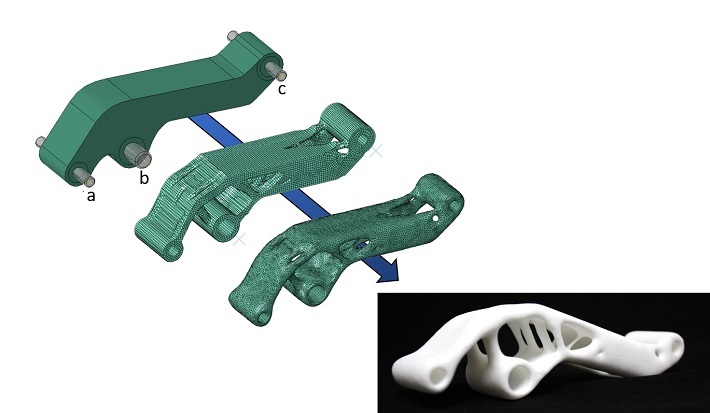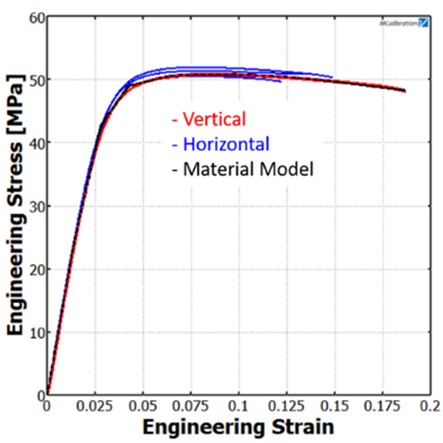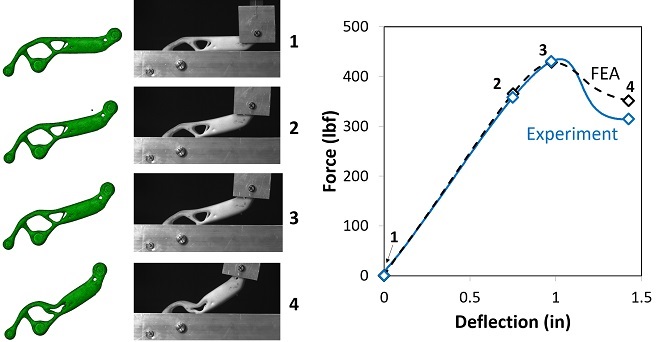Technical Challenge
Additive manufacturing (AM) enables the production of mechanically-superior parts by stripping away many of the design constraints imposed by conventional manufacturing methods. To take full advantage of the geometric complexity permitted by AM, engineers are increasingly relying upon topology optimization and other generative design tools.
While these tools excel at optimizing the elastic response of a part, failure of most additively manufactured polymers and metals involves large plastic deformation, which is not generally accounted for by generative design tools.
Therefore, accurately predicting the ultimate strength and failure modes of design concepts generated using topology optimization requires using advanced finite element analysis (FEA) that accounts for the nonlinear behavior of the material being used to make the part.
Veryst Solution
Veryst used experimental testing and finite element analysis to analyze the strength of an additively manufactured lever designed with topology optimization. Veryst engineers measured the mechanical behavior of the material, calibrated a nonlinear material model to the data, predicted the strength of the part using FEA, and then validated the FEA prediction through part-level testing. The optimization domain and structure of the lever are shown in Figure 1, along with a photo of the printed part highlighting the organic structure generated by the topology optimization software. The optimization maximized the stiffness of the lever while reducing the mass of the optimization domain by 65%.
To predict the ultimate strength of the lever shown in Figure 1, we needed to know the full stress-strain behavior of the material and whether or not we could ignore anisotropy. Because of the directional nature of additive manufacturing, virtually all AM materials exhibit some microstructural anisotropy. Whether this microstructural ordering leads to anisotropic mechanical properties depends on the material, the specifics of the processing, and what mechanical property is of concern.
Veryst’s testing lab measured the mechanical behavior of tensile specimens oriented both vertically and horizontally with respect to the build direction. Figure 2 shows the resulting stress-strain curves. The material exhibited effectively isotropic deformation behavior and so was modeled as isotropic. The dotted black line shows the material model used in the FEA of the part, which we calibrated using the MCalibration® software. For analyses requiring more sophisticated material models that can capture unloading response, time-dependent behavior, or temperature-sensitivity, the PolyUMod® library of user models provides the ability to build advanced models of AM polymers. (Both PolyUMod and MCalibration were developed by Veryst and are now available through PolymerFEM.com.)
Once we had calibrated a material model, we completed a finite element analysis of the part to failure to predict the maximum load the part could withstand. Additionally, we experimentally measured the strength of the lever using the same boundary conditions used in the FEA.
Figures 3 shows both the FEA and validation experiment results. The part failed by buckling on the top surface, which the FEA captures very well (see image 4 in Figure 3).
Additionally, the model accurately predicts both the stiffness and strength of the component. We measured the strength of the lever to be 435 lbf. The FEA predicted a strength of 428 lbf. This result validates the accuracy of our model for parts subjected to monotonically increasing load.
With accurate models for a given AM material/process combination in hand, engineers can rely on simulation to assess and modify design concepts generated using topology optimization to realize high-performance, high-value parts.
Learn more about additive manufacturing activity at Veryst.


